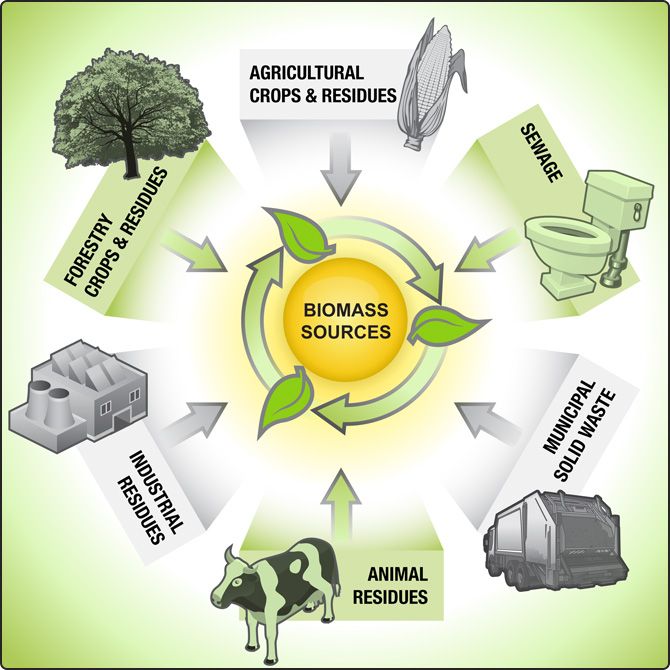Biomass
What is biomass and why it is important.
What does the product that is burning have similar to the product behind?,

You have to follow the video and listen to what it is talking about.
Read the text.
People have used biomass energy—energy from living things—since the earliest “cave men” first made wood fires for cooking or keeping warm.
Biomass is organic, meaning it is made of material that comes from living organisms, such as plants and animals. The most common biomass materials used for energy are plants, wood, and waste. These are called biomass feedstocks. Biomass energy can also be a non-renewable energy source.
Biomass contains energy first derived from the sun: Plants absorb the sun’s energy through photosynthesis, and convert carbon dioxide and water into nutrients (carbohydrates).
The energy from these organisms can be transformed into usable energy through direct and indirect means. Biomass can be burned to create heat (direct), converted into electricity (direct), or processed into biofuel (indirect).
Thermal Conversion
Biomass can be burned by thermal conversion and used for energy. Thermal conversion involves heating the biomass feedstock in order to burn, dehydrate, or stabilize it. The most familiar biomass feedstocks for thermal conversion are raw materials such as municipal solid waste (MSW) and scraps from paper or lumber mills.
Different types of energy are created through direct firing, co-firing, pyrolysis, gasification, and anaerobic decomposition.
Before biomass can be burned, however, it must be dried. This chemical process is called torrefaction. During torrefaction, biomass is heated to about 200° to 320° Celsius (390° to 610° Fahrenheit). The biomass dries out so completely that it loses the ability to absorb moisture, or rot. It loses about 20% of its original mass, but retains 90% of its energy. The lost energy and mass can be used to fuel the torrefaction process.
During torrefaction, biomass becomes a dry, blackened material. It is then compressed into briquettes. Biomass briquettes are very hydrophobic, meaning they repel water. This makes it possible to store them in moist areas. The briquettes have high energy density and are easy to burn during direct or co-firing.
Direct Firing and Co-Firing
Most briquettes are burned directly. The steam produced during the firing process powers a turbine, which turns a generator and produces electricity. This electricity can be used for manufacturing or to heat buildings.
Biomass can also be co-fired, or burned with a fossil fuel. Biomass is most often co-fired in coal plants. Co-firing eliminates the need for new factories for processing biomass. Co-firing also eases the demand for coal. This reduces the amount of carbon dioxide and other greenhouse gases released by burning fossil fuels.
Pyrolysis
Pyrolysis is a related method of heating biomass. During pyrolysis, biomass is heated to 200° to 300° C (390° to 570° F) without the presence of oxygen. This keeps it from combusting and causes the biomass to be chemically altered.
Pyrolysis produces a dark liquid called pyrolysis oil, a synthetic gas called syngas, and a solid residue called biochar. All of these components can be used for energy.
Pyrolysis oil, sometimes called bio-oil or biocrude, is a type of tar. It can be combusted to generate electricity and is also used as a component in other fuels and plastics. Scientists and engineers are studying pyrolysis oil as a possible alternative to petroleum.
Syngas can be converted into fuel (such as synthetic natural gas). It can also be converted into methane and used as a replacement for natural gas.
Biochar is a type of charcoal. Biochar is a carbon-rich solid that is particularly useful in agriculture. Biochar enriches soil and prevents it from leaching pesticides and other nutrients into runoff. Biochar is also an excellent carbon sink. Carbon sinks are reservoirs for carbon-containing chemicals, including greenhouse gases.
Gasification
Biomass can also be directly converted to energy through gasification. During the gasification process, a biomass feedstock (usually MSW) is heated to more than 700° C (1,300° F) with a controlled amount of oxygen. The molecules break down, and produce syngas and slag.
Syngas is a combination of hydrogen and carbon monoxide. During gasification, syngas is cleaned of sulfur, particulates, mercury, and other pollutants. The clean syngas can be combusted for heat or electricity, or processed into transportation biofuels, chemicals, and fertilizers.
Slag forms as a glassy, molten liquid. It can be used to make shingles, cement, or asphalt.
Industrial gasification plants are being built all over the world. Asia and Australia are constructing and operating the most plants, although one of the largest gasification plants in the world is currently under construction in Stockton-on-Tees, England. This plant will eventually be able to convert more than 350,000 tons of MSW into enough energy to power 50,000 homes.
Analise the photo.

Resource information